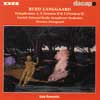Langgaard Symphonies Nos 4 & 5 (versions I & II)
One of Langgaard’s bestknown works with the première account of one of its lesswellknown alternative versions
View record and artist detailsRecord and Artist Details
Composer or Director: Rued Langgaard
Genre:
Orchestral
Label: Dacapo
Magazine Review Date: 9/2002
Media Format: CD or Download
Media Runtime: 57
Mastering:
Stereo
DDD
Catalogue Number: 8224215

Tracks:
| Composition | Artist Credit |
|---|---|
| Symphony No. 4, 'Løvfald' |
Rued Langgaard, Composer
Danish National Radio Symphony Orchestra Rued Langgaard, Composer Thomas Dausgaard, Conductor |
| Symphony No. 5, 'Steppennatur' |
Rued Langgaard, Composer
Danish National Radio Symphony Orchestra Rued Langgaard, Composer Thomas Dausgaard, Conductor |
| Symphony No. 5 |
Rued Langgaard, Composer
Danish National Radio Symphony Orchestra Rued Langgaard, Composer Thomas Dausgaard, Conductor |
Author:
On comparing different versions of the Fourth Symphony (9/01)‚ I suggested Dausgaard’s may well prove the best if it combined his first volume’s fine sound with Frandsen’s interpretative edge. Suffice to say that those expectations have been more than fulfilled: this is the best recording yet of this splendid‚ unconventional symphony.
Its more unassuming successor has a hopelessly complex history (of which more below). This is the third recording of the Fifth’s second (1931) version: comparing them shows how strong a Langgaard interpreter Stupel remains. Danacord’s sound is still acceptable if not as warm or precise as the competition’s and the playing is fullblooded if without the DNRSO’s knowledge of the style – one of the newcomer’s strongest attributes. It must also be said that Järvi’s tempi are very fast: the opening‚ for instance‚ is marked Lento misterioso‚ after all. True‚ the quasiSibelian Andante conclusion sparkles more for him‚ but Dausgaard’s new account almost matches it and throughout more of the detail can be heard. Dausgaard’s account is the slowest of all‚ at times a touch ponderous‚ but I suspect that this is right; Stupel runs him very close‚ however.
The real novelty here is the Fifth’s previous (1926) version‚ actually the third of five possible incarnations of a 191718 orchestral fantasia‚ Summer Legend Drama (‘Sommersagnsdrama’)‚ overhauled with new material in 1920 as Symphonic Festival Play‚ which was revised in 194041. The difference between the Symphony’s two versions is startling‚ explained by their being based respectively on Summer Legend Drama and Symphonic Festival Play rather than each other. Nowhere is the expressive divergence more fascinatingly audible than in Version 1’s conclusion: a haunting violin solo depicting the nix (a Nordic sprite)‚ which throws a wholly different light on the lowering‚ rushing string passage at the close.
Explore the world’s largest classical music catalogue on Apple Music Classical.
Included with an Apple Music subscription. Download now.

Gramophone Digital Club
- Digital Edition
- Digital Archive
- Reviews Database
- Events & Offers
From £9.20 / month
Subscribe
Gramophone Club
- Print Edition
- Digital Edition
- Digital Archive
- Reviews Database
- Events & Offers
From £11.45 / month
Subscribe
If you are a library, university or other organisation that would be interested in an institutional subscription to Gramophone please click here for further information.






